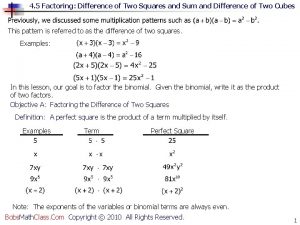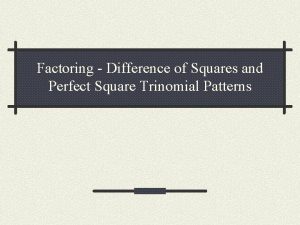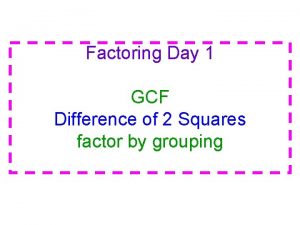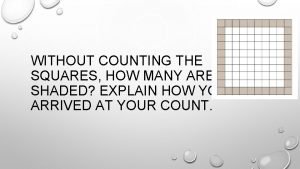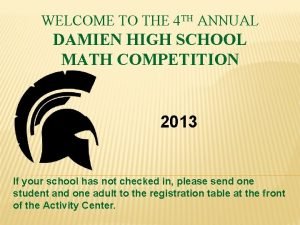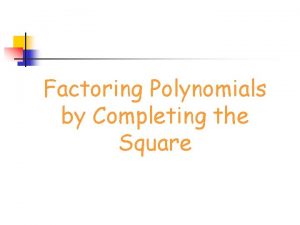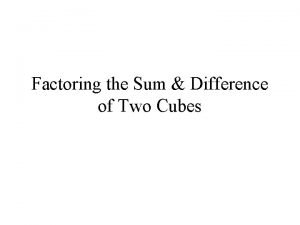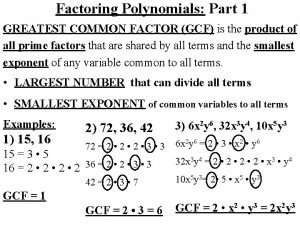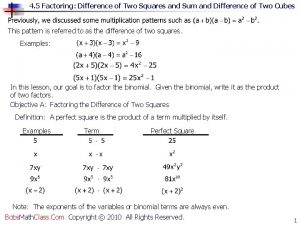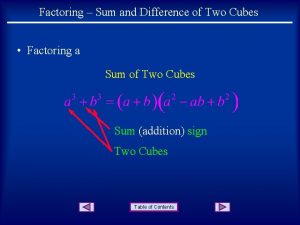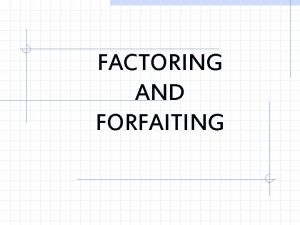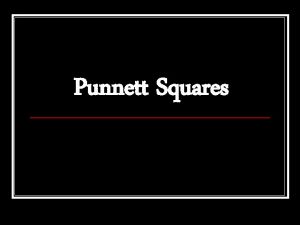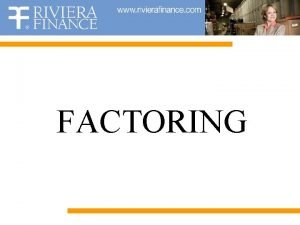4 5 Factoring Difference of Two Squares and










- Slides: 10

4. 5 Factoring: Difference of Two Squares and Sum and Difference of Two Cubes This pattern is referred to as the difference of two squares. Examples: In this lesson, our goal is to factor the binomial. Given the binomial, write it as the product of two factors. Objective A: Factoring the Difference of Two Squares Definition: A perfect square is the product of a term multiplied by itself. Examples Term Perfect Square Note: The exponents of the variables or binomial terms are always even. Bobs. Math. Class. Com Copyright © 2010 All Rights Reserved. 1

4. 5 Factoring: Difference of Two Squares and Sum and Difference of Two Cubes A Square Root is one of two equal factors of a number. Number Square Root Reason The Difference of Two Squares The Difference of Squares is a binomial where both terms are perfect squares and the sign of the binomial is subtraction (hence the word “difference”). Note that each term is a perfect square: 16 = 4 4, 4 x 2 = (2 x)2, 121 y 4 = (11 y 2)2, etc. Bobs. Math. Class. Com Copyright © 2010 All Rights Reserved. 2

4. 5 Factoring: Difference of Two Squares and Sum and Difference of Two Cubes Procedure: To factor the difference of two perfect squares: Step 1. Set up two sets of parentheses with one containing a “+” in the middle and the other a “–” in the middle. ( + )( – ) Step 2. Find the square root of the first perfect square and insert it in the first-term positions of the parentheses. Step 3. Find the square root of the second perfect square and insert it in the secondterm positions of the parentheses. Step 4. Check by FOIL. (4 x + 3 )( 4 x – 3 ) Step 1. Write parentheses with +/– Step 2. Find square root of first perfect square. Insert in first-term positions. Step 3. Find square root of second perfect square. Insert in second-term positions. Step 4. Check by FOIL. (Not Shown) Your Turn Problem #1 Bobs. Math. Class. Com Copyright © 2010 All Rights Reserved. 3

4. 5 Factoring: Difference of Two Squares and Sum and Difference of Two Cubes ( + )( – ) Step 1. Write parentheses with +/– Step 2. Find square root of first perfect square. Insert in first-term positions. Step 3. Find square root of second perfect square. Insert in second-term positions. Step 4. Check by FOIL. (Not Shown) Your Turn Problem #2 Does this binomial follow the pattern of the difference of two squares? Answer: No. The formula is only for the difference of two squares. There is no formula for the sum of two squares. Your Turn Problem #3 Bobs. Math. Class. Com Copyright © 2010 All Rights Reserved. 4

4. 5 Factoring: Difference of Two Squares and Sum and Difference of Two Cubes Recall from the last section, the first step in any factoring problem is to first factor out the greatest common factor. After factoring out the greatest common factor, proceed to factor using the pattern for the difference of two squares. Once the pattern of the difference of two squares has been used, verify that the binomials in the answer are not another “difference of two squares”. If it is, use the same pattern when necessary to factor completely. Step 1. Factor out GCF Step 2 -4. Factor difference of two squares Bring down common factor in front of parentheses. Step 5. Check by FOIL. (Not Shown) Your Turn Problem #4 Bobs. Math. Class. Com Copyright © 2010 All Rights Reserved. 5

4. 5 Factoring: Difference of Two Squares and Sum and Difference of Two Cubes Step 1. Factor out GCF Step 2. Factor difference of two squares Bring down common factor in front of parentheses. Step 3. Notice one of the binomials is the difference of two squares. Factor it and bring down other factors. Step 4. Multiply to check. Your Turn Problem #5 Bobs. Math. Class. Com Copyright © 2010 All Rights Reserved. 6

4. 5 Factoring: Difference of Two Squares and Sum and Difference of Two Cubes Objective B: Factoring the Sum and Difference of Two Cubes In the last objective, we covered a product of two binomials which resulted in the difference of two squares. In this objective, we want the product of two polynomials two obtain the sum or difference of two cubes. Example: which is the difference of two cubes. In the last objective, we had the pattern for the difference of two squares (there is no pattern for the sum of two squares). Here, we give the pattern for the sum and difference of two cubes. Sum and Difference of Two Cubes Bobs. Math. Class. Com Copyright © 2010 All Rights Reserved. 7

4. 5 Factoring: Difference of Two Squares and Sum and Difference of Two Cubes Perfect Cubes A perfect cube is a term which can be written using as an expression raised to an exponent of three. Examples: Procedure: To factor the sum or difference of two cubes Step 1. Rewrite each term as a perfect cube. Usually, the expression will be written in parentheses raised to the third power on the outside of the parentheses. Step 2. Decide which formula will be used. If between the cubes is a “+”, use the sum of two cubes. If between the cubes is a “–”, use the difference of two cubes. Write down which formula will be used. Step 3. Replace the “a” and “b” in the formula with the corresponding terms of the expression from Step 1. Step 4. Simplify each polynomial. Step 5. Check by Multiplying Bobs. Math. Class. Com Copyright © 2010 All Rights Reserved. 8

4. 5 Factoring: Difference of Two Squares and Sum and Difference of Two Cubes Step 1. Rewrite as perfect cubes Step 2. Since the sign between the two cubes is a minus, we will use the formula for the difference of two cubes. a=x b=2 Step 3. Replace “a” with “x” and “b” with “ 2” Step 4. Simplify Step 5. Multiply to check. (Not shown) Your Turn Problem #6 Bobs. Math. Class. Com Copyright © 2010 All Rights Reserved. 9

4. 5 Factoring: Difference of Two Squares and Sum and Difference of Two Cubes Step 1. Rewrite as perfect cubes Step 2. Since the sign between the two cubes is a plus, we will use the formula for the sum of two cubes. Write the formula using “x” and “y” since the problem is already contains the variables “a” and “b”. x=2 a y=3 b Step 3. Replace “x” with “ 2 a” and “y” with “ 3 b” Step 4. Simplify Step 5. Multiply to check. (Not shown) Your Turn Problem #7 The End. B. R. 1 -27 -09 Bobs. Math. Class. Com Copyright © 2010 All Rights Reserved. 10
